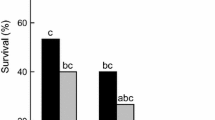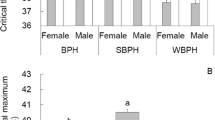Abstract
The cold-hardening capacity of larvae of the pink maize stalk borer,Sesamia nonagrioides Lef., was examined. Supercooling points (SCPs) of field collected diapausing larvae from south-east and south-west France and non-diapausing and diapausing laboratory-reared larvae did not differ and ranged between −5 and −8°C. Thus, this insect possesses sufficient supercooling ability to avoid freezing over its normal environmental temperature ranges. Despite this, we found thatSesamia presents paradoxical cold reactions. Mortality of cold acclimated diapausing larvae after short-term exposure to temperatures above the SCP is high, supporting the view thatSesamia is cold-sensitive. On the other hand,Sesamia could survive freezing for at least 24 h to temperatures close to the SCP. This ability does not seem to be related to haemolymph trehalose, the sole cold-accumulated compound detected by gas chromatography and mass spectrometry. Despite the mildness of the winter 1990–1991, only 5% of the field population survive and pupate in April. The main part of the population died from November to January, the period during which larvae were mainly located in the part of the corn stem above the ground and experienced air temperatures. After January, all surviving larvae were excuusively located in the root, 10 cm below the soil, where they experienced milder temperatures than air. They exhibited a constant low rate of mortality, possibly independent of the cold. In their current distribution area, survival of overwintering larvae ofS. nonagrioides is only related to the microclimate of the overwintering site and freezing tolerance capacity seems to be irrelevant. This study allows us to propose a non-pollutant pest control method based on the “behavioral strategy” of this insect.
Similar content being viewed by others
References
Asahina E (1969) Frost resistance in insects. Adv Insect Physiol 6:1–49
Al Salti, Galichet PF (1983) Influence de la plante-hôte sur les potentialités reproductives deSesamia nonagrioides Lef. (Lepidoptera, Noctuidae) au laboratoire. Oecol Appl 4:23–30
Bale JS (1987) Insect cold hardiness: freezing and supercooling, an ecophysiological perspective. J Insect Physiol 33:899–908
Bale JS (1991) Implications of cold hardiness for pest management. In: Lee RE, Denlinger DL (eds) Insects at low temperature. Chapman and Hall, New York, pp 461–498
Carpenter JF, Crowe JH (1988) The mechanism of cryoprotection of proteins by solutes. Cryobiology 25:244–255
Carpenter JF, Martin B, Crowe LM, Crowe JH (1987) Stabilization of phosphofructokinase during air-drying with sugars and sugar/transition metal mixtures. Cryobiology 24:455–464
Chippendale GM, Reddy AS (1973) Diapause of the south-western corn borer,Diatraea grandiosella: low temperature mortality and geographical distribution. Environ Entomol 3:233–238
Crowe JH, Crowe LM, Carpenter JF, Wistrom CA (1987) Stabilization of dry phospholipid bilayers and proteins by sugars. Biochem J 242:1–10
Danks HV (1978) Modes of seasonal adaptations in the insects. I. Winter survival. Can Entomol 110:1167–1205
Denlinger DL (1991) Relationship between cold hardiness and diapause. In: Lee RE, Denlinger DL (eds) Insects at low temperature. Chapman and Hall, New York, pp 174–198
Duman JG, Horwath KL (1983) The role of hemolymph proteins in cold tolerance insects. Annu Rev Physiol 45:261–270
Gallichet PF (1982) Hibernation d'une population deSesamia nonagrioides (Lep. Noctuidae) en France méridionale. Agronomie 2:561–566
Grubor-Lajsic G, Block W, Worland R (1992) Comparison of the cold hardiness of two larvalLepidoptera (Noctuidae). Physiol Entomol 17:148–152
Fediere G, Taha A, Abol Ela S, Lery X, Zeddam JL, Veyrunes JC;, Giannotti J (1993) A new granulosis virus isolated fromSesamia cretica Led. (Lepidoptera, Noctuidae) in north-east Africa: DNA characterization and viral diagnosis. CR Acad Sci 316:1350–1354
Hayakawa Y, Chino H (1981) Temperature-dependent interconversion between glycogen and trehalose in diapausing pupae ofPhilosamia cynthia ricini andpryeri. Insect Biochem 11:43–47
Lavenseau L, Hilal A (1990) Régulation des cycles saisonniers chez la Sésamie (Lépidoptère,Noctuidae). In: Les Colloques de P'INRA Ferron P, Missonnier J, Mauchamp B (eds). Régulation des cycles saisonniers chez les invertébrés. pp 243–246
Layne JRJr, Lee REJr (1987) Freeze tolerance and the dynamics of ice formation in wood frogs (Rana sylvatica) from southern Ohio Can J Zool 65:2062–2065
Lee RE (1989) Insect cold hardiness: to freeze or not to freeze. Bioscience 39:2308–2313
Lee RE (1991) Principles of insect low temperature tolerance. In: Lee RE, Denlinger DL (eds) Insects at low temperature. Chapman and Hall, New York, pp 17–46
Lee RE, Ring RA, Baust JC (1986) Low temperature tolerance in insects and other terrestrial arthropods: bibliography II. Cryoletters 7: 113–126
Mazur P (1984) Freezing of living cells: mechanisms and implications. Am J Physiol 247:C125-C142
Poitout S, Bues R (1970) Elevage de plusieurs espèces de LépidoptèresNoctuidae sur milieu artificiel simplifié. Ann Zool Anim 2: 79–91
Popham HJR, George MF, Chippendale GM (1991) Cold hardiness of larvae of the south-western corn borer,Diatraea grandiosella. Entomol Exp Appl 58: 251–260
Quinn PJ (1985) A lipid-phase separation model of low-temperature damage to biological membranes. Crybiology 22:128–146
Salt RW (1961) Principles of insect cold hardiness. Annu Rev Entomol 6: 55–74
Salt RW (1966a) Factors influencing nucleation in supercooled insects. Can J Zool 44: 117–133
Salt RW (1966b) Effect of cooling rate on the freezing temperature of supercooled insects. Can J Zool 44: 655–659
Scherrer B (1984) Biostatistique. Gaètan Morin, Québec
Storey KB, Storey JM (1988) Freeze tolerance in animals. Physiol Rev 68:27–84
Walters MC (1979) Maize pests of sub- Saharan Africa. In: Häfliger E (ed) Ciba-Geigy Maize. Basel, Switzerland, pp 66–71
Zachariassen KE (1985) Physiology of cold tolerance in insects. Physiol Rev 4:799–831
Ziegler R, Ashida M, Fallon AM, Wimer LT, Wyatt S, Wyatt GR (1979) Regulation of glycogen phosphorylase in fat body ofCecropia silkmoth pupae. J comp Physiol 131:321–332
Author information
Authors and Affiliations
Rights and permissions
About this article
Cite this article
Gillyboeuf, N., Anglade, P., Lavenseau, L. et al. Cold hardiness and overwintering strategy of the pink maize stalk borer,Sesamia nonagrioides Lef (lepidoptera, noctuidae). Oecologia 99, 366–373 (1994). https://doi.org/10.1007/BF00627750
Received:
Accepted:
Issue Date:
DOI: https://doi.org/10.1007/BF00627750




